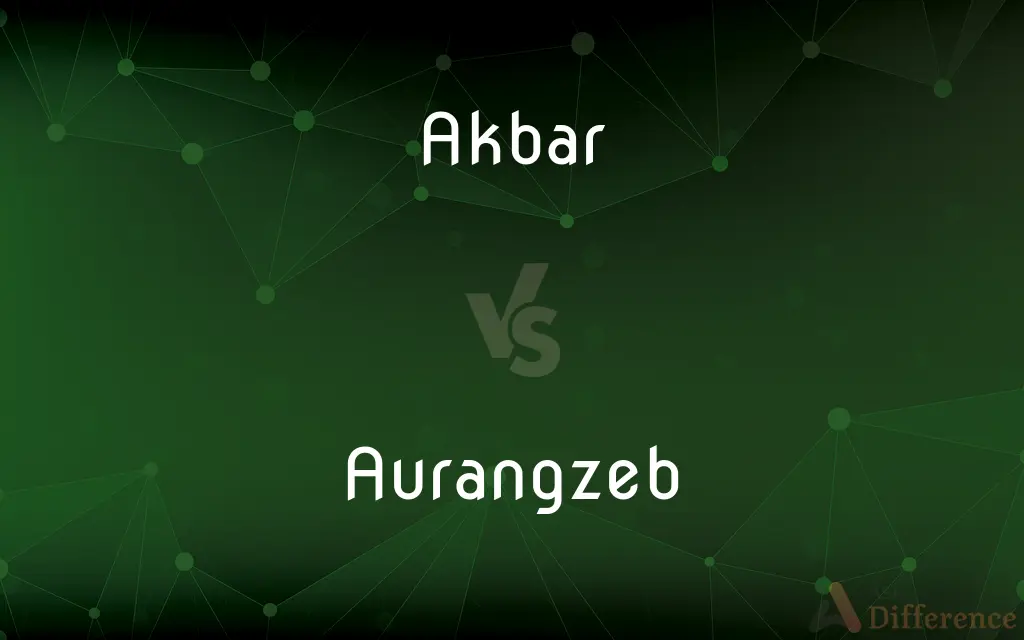Akbar vs. Aurangzeb — What's the Difference?
By Tayyaba Rehman & Urooj Arif — Updated on May 17, 2024
Akbar, known as Akbar the Great, expanded and consolidated the Mughal Empire through tolerance and diplomacy. Aurangzeb, ruled with strict adherence to Islamic law, leading to a more conservative and expansive but eventually strained empire.

Difference Between Akbar and Aurangzeb
Table of Contents
ADVERTISEMENT
Key Differences
Akbar, ruling from 1556 to 1605, is celebrated for his policy of religious tolerance and efforts to foster unity among his diverse subjects. Aurangzeb, who ruled from 1658 to 1707, implemented a more rigid and orthodox Islamic policy, which alienated non-Muslim communities.
Akbar's reign marked the expansion and consolidation of the Mughal Empire through diplomacy, marriage alliances, and strategic warfare. Aurangzeb expanded the empire to its greatest territorial extent but faced constant rebellions and administrative challenges due to his strict policies.
While Akbar abolished the jizya tax on non-Muslims to promote inclusivity, Aurangzeb reinstated it, reflecting his focus on Islamic orthodoxy. This shift led to increased resentment and resistance among non-Muslim populations.
Akbar encouraged cultural and intellectual exchange, patronizing arts, literature, and architecture, resulting in a vibrant cultural milieu. Aurangzeb, however, is known for his more austere approach, reducing patronage of the arts and focusing on religious conservatism.
Akbar's administration was characterized by a merit-based system that included diverse ethnic and religious groups, promoting efficient governance. Aurangzeb's reign saw increased centralization and militarization, with a stronger emphasis on enforcing Islamic law.
ADVERTISEMENT
Both emperors left significant legacies: Akbar is remembered for his innovative governance and cultural contributions, while Aurangzeb's legacy is marked by territorial expansion and the eventual weakening of the empire due to internal strife and external pressures.
Comparison Chart
Religious Policy
Tolerant and inclusive
Orthodox and conservative
Administration
Merit-based, inclusive governance
Centralized, militarized
Cultural Patronage
High, fostering arts and literature
Limited, focusing on religious norms
Territorial Expansion
Strategic and diplomatic
Extensive but contentious
Taxation Policy
Abolished jizya tax on non-Muslims
Reinstated jizya tax on non-Muslims
Compare with Definitions
Akbar
Third Mughal Emperor.
Akbar expanded the Mughal Empire significantly during his reign.
Aurangzeb
Centralizing Administrator.
Aurangzeb centralized the administration to reinforce control.
Akbar
Innovative Administrator.
Akbar reformed the administrative and taxation systems of the empire.
Aurangzeb
Orthodox Islamic Ruler.
Aurangzeb enforced strict Islamic laws during his reign.
Akbar
Patron of Arts.
Akbar’s court was a hub for artists and intellectuals.
Aurangzeb
Controversial Leader.
Aurangzeb's policies led to internal resistance and conflicts.
Akbar
Diplomat and Strategist.
Akbar used diplomacy and alliances to consolidate his rule.
Aurangzeb
Sixth Mughal Emperor.
Aurangzeb ruled the Mughal Empire at its territorial peak.
Akbar
Religious Tolerance Advocate.
Akbar promoted religious harmony through his policy of Sulh-e-Kul.
Aurangzeb
Military Expansionist.
Aurangzeb extended the empire through numerous military campaigns.
Akbar
Abu'l-Fath Jalal-ud-din Muhammad Akbar (Persian: ابو الفتح جلال الدين محمد اكبر; October 1542– 27 October 1605), popularly known as Akbar the Great, (Persian: اکبر اعظم, romanized: Akbar-i-azam), and also as Akbar I (IPA: [əkbər]), was the third Mughal emperor, who reigned from 1556 to 1605. Akbar succeeded his father, Humayun, under a regent, Bairam Khan, who helped the young emperor expand and consolidate Mughal domains in India.
Aurangzeb
Muhi-ud-Din Muhammad (3 November 1618 – 3 March 1707), commonly known by the sobriquet Aurangzeb (Persian: اورنگزیب, lit. 'Ornament of the Throne') or by his regnal title Alamgir (Persian: "Conqueror of the World"), was the sixth Mughal emperor, who ruled over almost the entire Indian subcontinent for a period of 49 years. Widely considered to be the last effective ruler of the Mughal Empire, Aurangzeb compiled the Fatawa-e-Alamgiri, and was among the few monarchs to have fully established Sharia law and Islamic economics throughout the Indian subcontinent.
Common Curiosities
What was Aurangzeb's religious policy?
Aurangzeb adhered to strict Islamic principles, reinstating the jizya tax on non-Muslims.
How did Akbar expand the Mughal Empire?
Akbar expanded the empire through diplomacy, strategic marriages, and military conquests.
Who was Akbar?
Akbar was the third Mughal Emperor, known for his policies of religious tolerance and administrative reforms.
How did Aurangzeb expand the Mughal Empire?
Aurangzeb expanded the empire primarily through military campaigns and conquests.
Why is Akbar considered a great ruler?
Akbar is celebrated for his innovative governance, religious tolerance, and cultural contributions.
Who was Aurangzeb?
Aurangzeb was the sixth Mughal Emperor, noted for his strict Islamic policies and territorial expansion.
What was Akbar's approach to religion?
Akbar promoted religious tolerance and inclusivity, abolishing the jizya tax on non-Muslims.
What cultural contributions did Akbar make?
Akbar patronized arts, literature, and architecture, fostering a rich cultural environment.
Did Aurangzeb implement any significant taxes?
Yes, Aurangzeb reinstated the jizya tax on non-Muslims.
How was Aurangzeb's administration different?
Aurangzeb's administration was more centralized and militarized, enforcing Islamic law strictly.
What was Aurangzeb's stance on cultural patronage?
Aurangzeb reduced patronage of the arts, focusing more on religious orthodoxy.
Did Akbar abolish any taxes?
Yes, Akbar abolished the jizya tax on non-Muslims to promote inclusivity.
How did Akbar's administration function?
Akbar's administration was inclusive and merit-based, incorporating diverse groups.
What legacy did Akbar leave?
Akbar's legacy includes a more unified and culturally rich empire with progressive governance.
What legacy did Aurangzeb leave?
Aurangzeb's legacy is marked by vast territorial expansion and eventual decline due to internal strife.
Why is Aurangzeb a controversial figure?
Aurangzeb's strict policies and military focus led to internal conflicts and resistance.
Share Your Discovery

Previous Comparison
Comfort vs. Soothe
Next Comparison
Solid vs. GasAuthor Spotlight
Written by
Tayyaba RehmanTayyaba Rehman is a distinguished writer, currently serving as a primary contributor to askdifference.com. As a researcher in semantics and etymology, Tayyaba's passion for the complexity of languages and their distinctions has found a perfect home on the platform. Tayyaba delves into the intricacies of language, distinguishing between commonly confused words and phrases, thereby providing clarity for readers worldwide.
Co-written by
Urooj ArifUrooj is a skilled content writer at Ask Difference, known for her exceptional ability to simplify complex topics into engaging and informative content. With a passion for research and a flair for clear, concise writing, she consistently delivers articles that resonate with our diverse audience.
















































